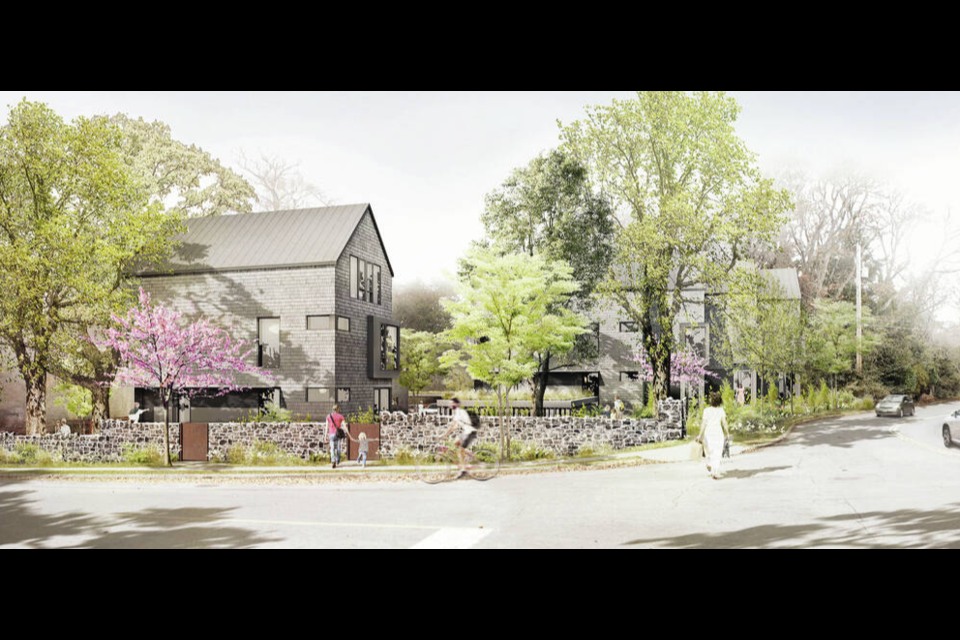A controversial townhouse project that has been three years in the making has been approved for the 900 block of Foul Bay Road.
Victoria council voted Thursday to green-light Aryze Development’s 18-unit townhouse project at 902 Foul Bay Rd.
“It feels great but you know, this shouldn’t be the process,” Aryze developments principal Luke Mari said of the years to took to get a decision. “Obviously it feels amazing to finally get this approved.”
Mari said the company could have taken the path of other developers in the area and subdivided the lot and built more single-family homes.
“There are three others within a one-kilometre radius — people that bought large lots like this, subdivided them, built housing, sold them off, and moved on in the same time span it took us just to get to council,” he said.
“We took the hard road because we believed in it, and it’s nice to finally be successful.”
The building-permit approval process could still take several months, Mari said, estimating it could be nine month before construction begins.
“We still have, you know, a bit of a way to go.”
The half-acre corner lot is bordered by Foul Bay Road, Quamichan Street and Redfern Street. It has been vacant since 2016, when a 1911 heritage house burned to the ground.
Aryze is planning to construct two three-storey buildings to house the 18 units. Residents will be offered car-share memberships, with $100 in usage credits and at least 30 long-term bicycle parking spaces, half of them with electric-bicycle charging capability, and a bicycle repair stand with tools and a wash area.
The project requires removing 28 trees, including 17 that are protected under the city’s tree preservation bylaw. Another 14 trees would be retained, and 33 would be planted to meet the city’s two-for-one replacement ratio.
Before voting to approve the project, Mayor Lisa Helps acknowledged Thursday that the long delays point to problems in the approval process, noting the project lost out on qualifying for a provincial affordable home ownership program because the delay drove up the cost.
“When it takes three years to get to the process of approving 18 townhomes, I think we have a giant process problem,” she said. “It’s affecting affordability. And I think that that’s something that we need to take really seriously. I don’t want to be part of a city or a council that has a process where it takes three years to get 18 townhomes in front of us when, as we heard at the public hearing, these townhomes are so desperately needed.”
The project was controversial due to its size and the number of trees affected, but council voted 7-2 in favour — councillors Geoff Young and Charlayne Thornton-Joe were opposed — weighing the need for housing against the downside.
Helps said the job of a council is to balance needs. “Even if we do nothing today, which I hope we don’t, the owner could build four homes and four outbuildings and we’d see the same number of trees disappear,” she said.
Helps also said this is the kind of housing Victoria needs to meet demand from families. “I hope that will send a signal that we need more of these kinds of homes that have the compact sustainable footprint that we want in a city that is going to grow.”
Coun. Jeremy Loveday said the empty site provided a rare opportunity in a built-out city to construct family homes without displacing people.
“I think the proposal that’s in front of us is sensitive to the neighbourhood and the design is thoughtful and relatively attractive,” he said, adding he would have preferred the pricing to be more affordable, but such is the nature of the current housing market.
Young said just because the price of housing is high and it’s hard to find rental housing is no reason to approve every project.
“I do agree this is an unusual lot and I think it does deserve some intensification of use,” said Young, who has argued the project is too big for the lot and the area.
“I think it might have been reasonable to have a more modest townhouse development at a slightly lower scale.”
>>> To comment on this article, write a letter to the editor: [email protected]



